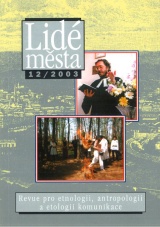K původu a pramenům českého lidového spiritismu
DOI:
https://doi.org/10.14712/12128112.4330Abstrakt
In the second half of the 19th century and at the beginning of the 20th century, spiritualist ideas massively spread in the entire Euro-American region, including broad masses. Hand in hand with this spread, there was also an intellectual rejection, which for long frustrated any serious study of the phenomenon. Besides, popular forms of the spritualist movement have always been considered as decayed and unworthy of acedemic interest. The situation has only recently improved. In fact, it has turned out that popular spiritualism cannot be in all cases reduced to a sort of intellectual hermetism and pseudo-scientific disciplines. Moreover, just the popular spiritualism often had a deep, distinctive ethical and religious imprint. Spiritualism in general spread in Bohemia (several hundreds of thousands of sympathisers, but with only about 10.000 of them actively practicising) at the close of the 19th century under the foreign influence on intellectual circles and through them (mainly by literature) on the people. By contrast, there were much older, popular spiritualist ideas, whose existence can be proved bx as early as 1850s. They were hidden in some inaccessible parts of the country, in Podkrkonoší and in the environment of Stradouň in Vysoké Mýto region. In both of these cases, spiritualism was one of the transformed forms of East Bohemian "toleration-era" sectarianism, a popular religious movement of unauthorised lay specualations, which surfaced after the Toleration Edict was issued in 1781. Given its religious roots, it is understandable that popular spiritualism retained in the described regions its religious character, a strict ethical code and the nature of a sect in line with the Weber-Troeltsch terminology. Along with direct genealogies and analyses of theological shifts, which occured in the course of transformation of sectarian religious notions into the spiritual ones, one can also watch a continual transition between the two movements especially in their explicit references to the tradition of Czech reformation, opposition to the Catholic church and its symbols, their inclination to the "implicit religious feeling" (socialism, communism) and survival of pre-scientific forms of thinking, traditional medicine, and astrology. However, nothing of this sort can be said about the intellectual, urban spiritualism, which created the real reverse of the popular movements in these points. Besides, its ethic and day-to-day practice was often low, allowing a superficial faith, often just as a kind of entertainment or even existing for selfish reasons. The two forms of the spiritualist movement only merged approximately in the period of World War One, evidently in connection with the establishment of the Brotherly Association of Czech spiritualists (K. Sezemský), when the described popular and religious spiritualism was virtually swallowed up by the spiritualism of urban type. Undoubtedly, this was mainly caused by the numerous predominance of the urban form because the starting the beginning of the century it also spread to the country, but outside the traditional sectarian regions (here one can rightly speak about an ideological degeneration). Alongside this, there was an intellectual decay of the late sectarianism and eventually also the establishment of the Czechoslovak church (1920), where many sectarians and later spiritualists eventually found shelter. The study of the beginnings of popular spiritualism is hampered by a number of heuristic difficulties, especially on account of a hostile attitude of contemporaries to the movement. As a result, it is very difficult to find sources at present. Luckily, a part of a private collection of "medium" drawings was preserved. They were assembled before World War One by regional researcher František Večerník (1877-1958), a teacher in Lomnice nad Popelkou. Some drawings from the collection are printed here. In fact, it can be clearly stated that their character, used types of motives as well as the mode of creation conflict with the tradition of spiritualist graphic arts from other regions. ln a way, these drawings, too, are indirect evidence of a distinctive character of the popular spiritualisrn of the region of Podkrkonoší and its independence from urban ideological resources.
Stahování
Publikováno
Jak citovat
Číslo
Sekce
Licence

Tato práce je licencována pod Mezinárodní licencí Creative Commons Attribution-NonCommercial-NoDerivatives 4.0.


